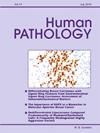Lymphoplasmacytic lymphoma and Waldenström macroglobulinemia, a decade after the discovery of MYD88L265P
IF 2.7
2区 医学
Q2 PATHOLOGY
引用次数: 0
Abstract
There has been remarkable progress over the past 80 years since Jan Waldenstrom first described patients with a hyperviscosity syndrome related to IgM paraprotein in 1944. The definition of Waldenstrom macroglobulinemia (WM) has evolved from a clinical syndrome to a distinct clinicopathologic entity with characteristic morphology, immunophenotype and molecular features. The landmark discovery of MYD88 mutation among most WM cases in 2012 marked the dawning of an era of molecular genomic exploration that led to a paradigm shift in clinical practice. In the current World Health Organization (WHO) classification of hematologic neoplasms, WM is included in the category of lymphoplasmacytic lymphoma (LPL) of which WM represents over 90% of cases. LPL/WM is also better defined, resolving ambiguity in many cases that would have been classified as “low-grade B-cell lymphoma with plasmacytic differentiation” a decade before. Nevertheless, challenges still face pathologists because criteria for distinguishing LPL/WM from other types of low-grade B-cell lymphoma, particularly marginal zone lymphoma (MZL), remain imperfect. In this review, we highlight the current understanding of LPL and WM brought to light by new discoveries, which in turn are increasingly translated to improved diagnosis and personalized therapy. Key concepts in the diagnosis and their clinical implications are emphasized. Controversies and challenges are also discussed.
淋巴浆细胞性淋巴瘤和Waldenström巨球蛋白血症,MYD88L265P发现十年后。
自1944年Jan Waldenstrom首次描述与IgM副蛋白相关的高粘滞综合征患者以来,在过去的80年里取得了显著的进展。Waldenstrom巨球蛋白血症(WM)的定义已经从一种临床综合征演变为一种独特的临床病理实体,具有独特的形态、免疫表型和分子特征。2012年,在大多数WM病例中发现了具有里程碑意义的MYD88突变,标志着分子基因组探索时代的到来,这导致了临床实践的范式转变。在目前世界卫生组织(WHO)的血液肿瘤分类中,WM被纳入淋巴浆细胞性淋巴瘤(LPL)类别,其中WM占90%以上的病例。LPL/WM也得到了更好的定义,解决了许多病例在十年前被归类为“低级别B细胞淋巴瘤伴浆细胞分化”的模糊性。然而,病理学家仍然面临挑战,因为区分LPL/WM与其他类型的低级别B细胞淋巴瘤,特别是边缘区淋巴瘤(MZL)的标准仍然不完善。在这篇综述中,我们强调了目前对LPL和WM的新发现所带来的理解,这些新发现反过来又越来越多地转化为改进的诊断和个性化治疗。强调诊断中的关键概念及其临床意义。讨论了争议和挑战。
本文章由计算机程序翻译,如有差异,请以英文原文为准。
求助全文
约1分钟内获得全文
求助全文
来源期刊

Human pathology
医学-病理学
CiteScore
5.30
自引率
6.10%
发文量
206
审稿时长
21 days
期刊介绍:
Human Pathology is designed to bring information of clinicopathologic significance to human disease to the laboratory and clinical physician. It presents information drawn from morphologic and clinical laboratory studies with direct relevance to the understanding of human diseases. Papers published concern morphologic and clinicopathologic observations, reviews of diseases, analyses of problems in pathology, significant collections of case material and advances in concepts or techniques of value in the analysis and diagnosis of disease. Theoretical and experimental pathology and molecular biology pertinent to human disease are included. This critical journal is well illustrated with exceptional reproductions of photomicrographs and microscopic anatomy.
 求助内容:
求助内容: 应助结果提醒方式:
应助结果提醒方式:


